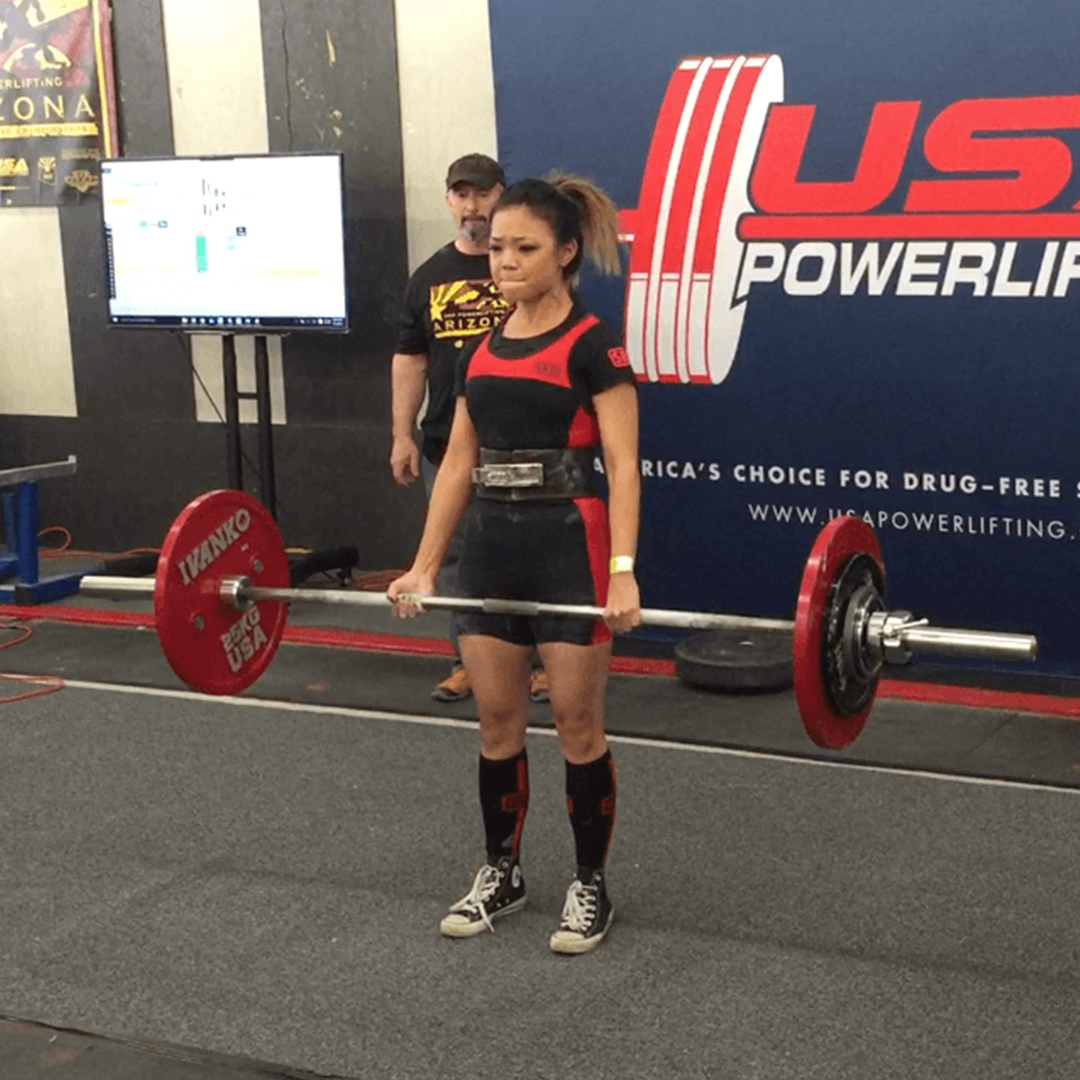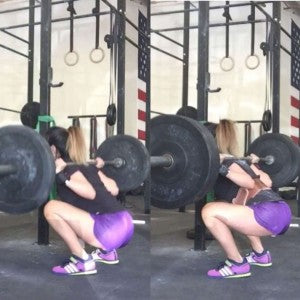So You Want to Be a Powerlifter? Here are 20 Things You Need to Know

The basic premise of any powerlifting meet is as follows: you compete with other individuals in your gender and weight class, and you have to perform the back squat, deadlift, and bench press; you have three attempts for each lift, and you only have to select your opening attempt before the meet begins; you need at least two white lights out of three in order for an attempt to count.
That’s all fine and well, but chances are, if you’re new to the sport of powerlifting, you have 101 questions. Where do you begin? How should you approach your training? What if you don’t fit in?
Here are 20 things you need to know.
1. Anyone can be a powerlifter so long as you can perform the back squat, deadlift (sumo or conventional), and bench press. There are no specific strength requirements that you need to qualify for by any means, so remove those “I’m not strong enough to compete” thoughts from your head. I’m far from an elite powerlifter, but I probably have more fun than anyone, both during training and at the meets. There’s no reason to ever be ashamed of your numbers – I know I sure as hell am not.
2. If you’re on the fence about competing, find a local powerlifting meet near where you live and check it out as a spectator. You’ll notice pretty quickly on that no one is jeering or mocking anyone who fails a lift or doesn’t have world record-breaking numbers; in fact, the environment is overwhelmingly positive and supportive. Cheering and hollering and clapping are the norm for athletes up on the platform. Even spending an hour in the audience will give you a pretty good idea of what a meet is like and will probably get you pumped up to participate as a competitor one day.
3. When picking a meet, take into consideration the federation you want to compete in, the date of meets available, and the geographic locations. The USAPL is considered the gold standard, so try and go that route if possible. However, if there are no USAPL meets available in the next few months that’s within driving distance for you, it’s perfectly okay to pick a different federation. 100% Raw and UPA are also good.
4. For your first meet, it’s probably better to register for the weight class that you can slide into without extra effort. This means that if you’re between two weight classes, go for the higher one. Unless you’re hovering just a couple of pounds above the lower weight class, it’s not worth cutting back calories to risk losing strength. (As an example, earlier this year, I was sitting at around 109lbs, and I thought it would make sense to diet down for the 103lb weight class – this means that I would have had to come in exactly at or under 103lbs. It only took one week in a mild caloric deficit for me to feel markedly weaker and realize that forcing myself into the lower weight class just to match last year’s numbers would have wasted a whole year’s worth of hard training.) The one exception would be if you know that you have the potential to set a record in the lower weight class and your strength numbers can stay intact or even increase while you diet down.
5. Take the time to learn the technicalities of how to lift like a powerlifter. For back squat, you typically have to hit parallel (hip crease in line with or lower than knee joint); a powerlifting-style bench press is different from a standard bodybuilding-style bench press, mainly in that a full pause is required at the bottom of the rep, and you want to get in a good arch to shorten the range of motion; and the deadlift requires a full lockout at the top. It’ll probably be in your best interest to recruit the help of a powerlifting coach – or at the very least, educate yourself on what proper form entails.
https://www.instagram.com/p/BD4NL5zThx5/?taken-by=soheefit
6. Pick a meet several months out (I would recommend 3-5 months), and then reverse-engineer your program so you always know how many weeks you have to train and where you are in your training cycle relative to the big day.
7. Recruit a training partner if possible. I was not able to do this for the meets that I competed in mostly due to geographic restriction and my time availabilities, but I know that having someone to keep you accountable, spot you on your sets, and push you during your grinders can make a huge difference in training experience.
8. When training, err on the side of caution. Go deeper on squats than you think you need to (this means going well below parallel), pause a smidge longer for your bench press reps, and squeeze those cheeks at the top of the deadlift. It’s better to be over-prepared come meet day than to be chagrined when you get red-lighted left and right.

9. Make every set a quality set. Treat your warmup sets like you would your heavy working sets. The lighter sets are a perfect opportunity for you to really hammer home a strict setup and groove proper movement pattern. You don’t want to be chitchatting with your girlfriend while you’re repping our squats or letting your mind wander mid-rep.
10. Keep a training log and track your strength increases. You should be improving upon your big lift numbers from month to month. Pay attention to whether or not you’re actually progressing and how your body is feeling. While strength gains are not linear, you should be noticing a general upward trend over time.
11. Keep form as intact as possible. It’s not unusual to see some serious round back pulling at a meet, as that’s how many people are stronger. However, the more you train in this manner and the more you let your lumbar round, the higher the risk of injury. The last thing you want is to get hurt, as this will keep you sidelined for weeks, if not months and years. Practice good form whenever possible and minimize form breakdown.
12. Don’t underestimate the importance of rest. If you’re constantly grinding out every single working set day after day, you’re not giving your body a chance to recover. By rest, I’m referring both to how many days you’re taking off from the gym as well as the quality and quantity of your sleep. You should also have scheduled deloads throughout your training so you don’t run yourself into the ground – this is one thing that my coach and I did not do during my most recent prep that likely contributed to my poor bench press performance.
13. Keep an eye on scale weight. Unlike a bodybuilding, figure, or bikini competition, in powerlifting, it doesn’t matter how you look. There is zero focus on your aesthetics; all that matters is what weight class you’re in and how much weight you can lift. You don’t have to become obsessive, but you would be remiss not to keep a pulse on how much you weigh just to ensure that you’re where you want to be. For me, I typically set a 4lb window and I try not to let myself lower or higher than that range. If you’re too heavy, you won’t make your weight class; if you’re too light, that may mean you’re not consuming sufficient calories and your training will suffer. Find that sweet spot where you can eat enough and continue getting stronger in the gym.
14. Check your particular federation’s approved gear list early. You don’t want to be that person (eh hem, me) who doesn’t think to look up the gear list until two weeks out from her meet and then have to scramble to make sure that everything is purchased and delivered on time. This is irresponsible and adds unnecessary stress. You may be restricted to a specific brand of singlet, t-shirt, wrist wraps, knee sleeves, and belt, so purchase these early. You’ll also want the time to be able to wear in your belt and wrist wraps in particular.
15. Practice the commands. For squat, you have the “start” and “rack” commands; for bench, you have “start,” “press,” and “rack”; and for deadlift, you just have the one “down” command. Familiarize yourself with these so you don’t let your nerves get to you and you accidentally squat before you’ve been given the go-ahead.

16. Shoot for 9/9 at your first meet. This means that every attempt for every lift is considered a go and no attempts have been disqualified. It’s better to walk away from a meet thinking that you could have totally ripped 10 more pounds off the floor and use that as motivation to smash it out of the ballpark for your next meet than to try at a weight, fail, then kick yourself for letting your ego get in the way. Your first attempt is a confidence builder (so a weight that you have easily hit multiple times during training), your second attempt should be close to your max, and then your last can be a PR attempt.
17. Take your taper seriously. The week of the meet, try not to introduce any new foods into your diet. Stick to what you know your stomach can handle. As well, this is not the time to go skydiving for the first time or split your shin open doing high-rep box jumps taking a last-minute bootcamp class. Lay low, stay out of trouble, and keep the theatricals to a minimum.
18. Bring plenty of food and drink for the day of the meet, but again, keep your options safe. You want to stick to mostly easily digestible carb sources. I like to toss a few Monsters and Gatorades into my bag as well as bananas, dried fruit, gummy bears, peach rings, and other fun snacks. My friends Karey and Eric also brought me a bag of donuts for after weigh-ins, and I ate two throughout the course of the meet. You may not have much of an appetite, but it’s better to have leftover food than to run out of sustenance.
19. Rather than comparing how your numbers stack up to other individuals in your class, focus more on how you can perform your best. Then, if you decide to do another meet in the future, you should strive to beat your own personal best numbers.
20. Keep a positive attitude and be a good sport. Cheer for others, even those in your weight class. You may do extremely well, and that’s something you can celebrate. If you miss a lift or get called for a technicality, it’s not the end of the world. The worst thing you can do is throw a tantrum and look childish. Use your mistakes as a valuable learning opportunity so you can do even better the next time around.

Competing in a powerlifting meet involves a lot more than simply getting strong in the three lifts. Powerlifting can be incredibly fun as long as you dot your i’s and cross your t’s, so make sure you have all of your ducks in a row in preparation for the big day.




